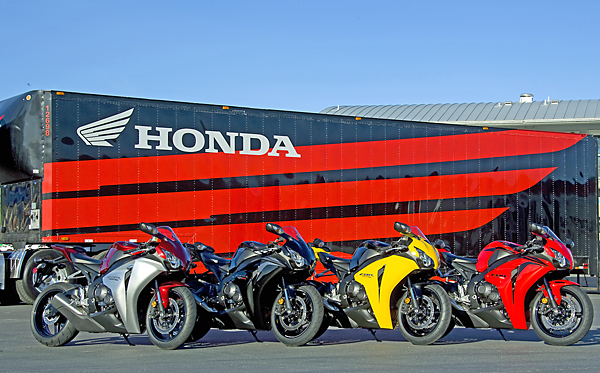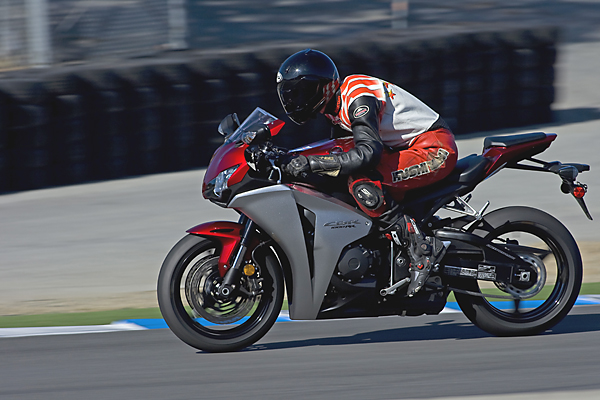
It’s your birthday. You sit before an inferno of flames (OK, maybe you’re younger than I am). What kinds of wishes are going through your mind? Maybe a plasma TV? How about a new bike? OK, now we’re getting somewhere. But what kind of bike? This is your birthday and you’re making wishes! So let’s make a wish.
You know you want something with MotoGP in its DNA. A lot of it. It’s gotta have the signature pedigree of a world champion, say, Nicky Hayden. Of course, it should spring from the hand and mind of a god of Grand Prix … Kyoichi Yoshii of HRC, the demigod behind the RC211V. That’d be the guy.

Naturally, such a creation would be light and lithe. 435 pounds, wet, at the curb, full of gas and ready for a long day of unwinding your favourite tarmac. And horsepower! TONS of it, natch, but hey, you’re going for a ride so you need to be able to use it, not be prohibited by some vestigial survival instinct. It’s gonna be small but comfortable. Precise yet forgiving. Fast though tractable. It’s gotta wrap a whole lotta cool kung fu in something you can swing a leg over, but still become part of.
Close your eyes and blow the wax from those cheap candles across the room! Uh, oh…you forgot to take a deep breath! No worries, mate, because you don’t need to wish. This bike exists, and this spring you can have one for less than Paris Hilton pays for a pedicure. Well, after the tip anyway.
No doubt this bike is the 2008 Honda CBR1000RR. There’s not much hype in the hoopla. Honda went all out to redesign the new flagship liter bike, and they’ve adhered to a core set of First Principles to bring us something very special. These principles are: incorporate race proven technology, maximize power to weight, and create new technology. Honda invited MD to Laguna Seca to prove to us how well they hit the mark.
One of the first things you notice about the new 1000 is its styling. Maybe you like it, maybe you don’t. But take a moment and think about what you see. It’s narrower, for one. From the profile you can see that the fairing upper is shorter, almost stubby. Honda claims this is a functional design to minimize the effort required to change direction at high speed.
 The exhaust pretty much catches your eye right away. Is that a bad thing? Or does it just intrigue you? It looks awfully low-slung, tidy … and angular. The bike surely has reduced frontal area for improved aerodynamics. The integrated mirrors and turn indicators are pretty slick; that obviously consolidates two sources of drag.
The exhaust pretty much catches your eye right away. Is that a bad thing? Or does it just intrigue you? It looks awfully low-slung, tidy … and angular. The bike surely has reduced frontal area for improved aerodynamics. The integrated mirrors and turn indicators are pretty slick; that obviously consolidates two sources of drag.
What’s tugging on the back of your mind is that Honda has placed function over form. No matter what, the design that performed better won the day. Are high pipes stylish? Maybe so, but they deliver mass high on the platform and near the rider. The single most important aspect of the “power to weight” principle for this mega-horsepower liter bike is not power or weight. It’s where you put the weight and how you make and manage the power. Laguna Seca provided an excellent opportunity to put these principles to the test. There’s no place to rest, and every turn flows into the next over elevation changes and blind rises. A good mix of fast turns and low gear exits provides a litmus test for throttle control and chassis response.
When you slip into the contours of the ’08 CBR1000RR, one the first things you notice is that the riding position is relaxed and forgiving. But not so much that you can’t be aggressive. And it’s narrow. My average 5’10” frame was never crowded, folded, or forced to interfere with itself. Your legs can meld with the fuel tank and not feel like they’re being pried apart. There’s 1000cc of big inline four between ya and you’d never know it from the supermodel waistline. In fact, in the effort to reduce and centralize mass, Honda managed to make the engine 30mm narrower at the frame rails and 15mm shorter from the cylinder block. This narrow engine now has an integral bottom end and cylinder block. The sleeveless cylinders are more closely spaced and plated with a nickel silicon carbide (aka Nikasil) matrix that is similar to the platings used on Honda’s grand prix two-stroke cylinders.
Since the engine is shorter, it allows 3mm shorter exhaust valves and moves the super-light cams closer to the center of mass. Together, the new cams are a whopping 1.1 pounds lighter than before … and that’s rotating engine mass. The larger bore pistons (up 1mm from 75mm) are of identical weight to the ’07. All of that yields an engine that is 5 pounds lighter. The curved radiator is narrower as well, but the January test conditions at Laguna won’t serve to test how well the bike cools. This might be one to keep your eye on.
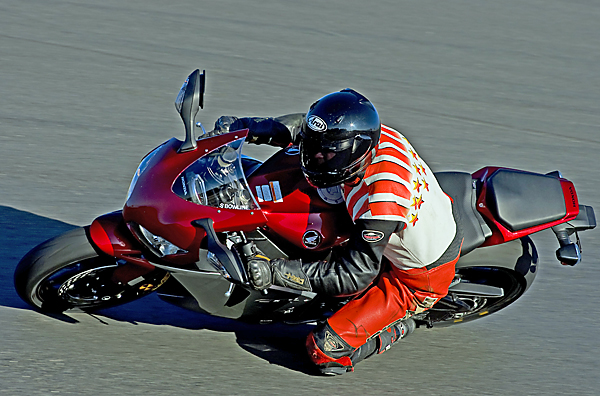
Rolling down the hot pit and entering the track, some of the engine and geometry characteristics are already obvious. The HESD (Honda Electronic Steering Damper) senses the casual pace and steering around obstacles at low speed is effortless. You roll off a little, steer, roll back on, and there’s an odd feeling. It’s not jerky. There’s no driveline lash, but there’s something going on that doesn’t feel like every other bike. It’s the Honda Ignition Interrupt Control system. This is an interesting bit of new technology that you can’t really test on a racetrack, but swinging around the gas pumps or maneuvering around the parking lot you might be glad it’s there.
The IICS measures the rotational velocity differential between the crankshaft and the countershaft. This is zero when the transmission is fully engaged under acceleration or deceleration, but in the transition between the two there’s a very brief moment of time when the gear dogs are off their leash and the cog is free to rotate a few degrees. At this point the countershaft and crankshaft are no longer rotating at exactly the same rate. And when this difference reaches a pre-programmed threshold (different for each gear and only between 2000 and 6500 RPM) the IICS will kill ignition pulses to soften the clack when the dogs engage. So this obviously isn’t something you’ll notice or need on the racetrack, or even during sportriding, but it’s a good example of the lengths Honda has gone to in order to tame their new full liter beast.
Like any bike in its class, the CBR1000RR pulls hard and strong. Usually longer than you have racetrack, so there’s never a moment when you’re not under the spell of acceleration. At Laguna, you can fall deep into this intoxicating trance as you exit Turn 3 and rocket, with measured application of throttle, through Turn 4 and accelerate at just shy of relativistic speeds to Turn 5. You’ll welcome the narrower fuel tank at times like this, as you can get a pretty good grip on it (or at least you’d better) with your legs.
Turn 4 doesn’t require much braking, even on big bikes, but it does require that you roll out and set both your entry speed and turn point. This is a transition. You’re on the gas, you’re off, you’re turning, and then you’re on the gas again. But you wouldn’t know it was so complicated. Honda’s latest incorporates another bit of new technology called the Idle Air Control Valve.
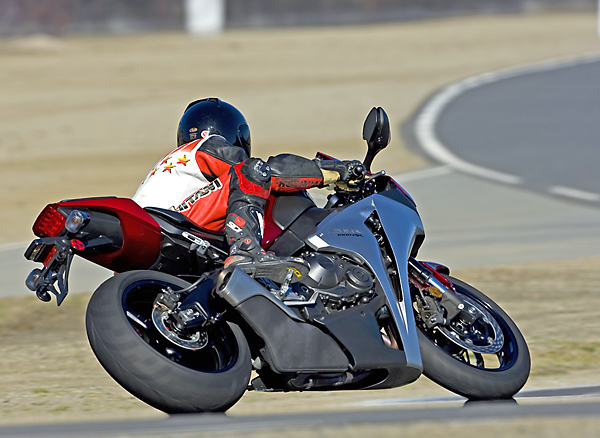
Technically, this system debuted on the ’07 CBR600RR, but its refinement in the ’08 is quite an accomplishment because you’d never know it was there. The system uses a stepper motor controlled valve (to allow varying amounts of air, rather than just being full open or closed) to bleed air through the closed butterflies of a throttle body and raise the idle speed. This reduces engine braking. This also eases the transition back to acceleration. It’s not clear what kind of effect the system has in corner approaches like this, but for the next bend, Turn 5, there’s some significant braking, turning and throttle transitions all happening at the same time. And it’s all effortless.
Effortless, that is, except for the braking. Shedding 290,000 joules of energy is no easy task. That’s the combined mass of motorbike and this rider slowed from 130mph to 80mph. It takes a 75watt light bulb an hour to do that. How long does it take your brake fingers? I’m not sure, but when Turn 5 is looming large it had better be a lot sooner. The new 1000RR does a compentent job in this department. As part of the Yoshii-san diet plan, the monobloc calipers are 4 ounces lighter and have aluminum pistons that, all combined, save 1 pound of unsprung weight. Add to that Suzuka 8 Hour-derived rotors with some serious thought and empirical data applied to where the holes should be, and you might expect something extraordinary when you pull the brake lever. But alas, the brakes are “merely” up to the task, and not nearly as special as the CBR1000RR as a whole.

Braking as hard as you please, the front is quite stable with minimal dive. The transition from braking to accelerating through the apex is aided by another new technology, the Assisted Slipper clutch. This is probably one of the best enhancements to the package, because it affects the bike in a lot of different situations. The slipper unit doesn’t just help you out on those frenetic downshifts and late apex bombing runs, it actually helps reduce clutch hand fatigue, improves feel, and saves weight. It accomplishes all of this because it eliminates heavy clutch springs and hydraulic plumbing. The clutch is cable operated. Here’s how it works.
To begin with, it probably shouldn’t be called a slipper clutch. Slip/Anti-Slip is more like it. The Slip/Anti-Slip design uses the engagement surfaces between the clutch plates as a cam to both increase the pressure under crankshaft acceleration and reduce the pressure during crankshaft deceleration. The lighter clutch springs are a godsend, and the system works
seamlessly. In fact, the direct, linear feel of the strictly mechanical lever, and its light pull are surprising on a bike this powerful. In terms of outright slipper performance the jury is still out. Without doing a back to back test, I’d say there are slipper units that might work better in slip mode; however, this clutch will probably win over lots of fans for its overall performance.
The power delivery of the new CBR1000RR could almost be described as confidence inspiring. That seems like an oxymoron for a modern liter bike, but many things have come together to keep the rider confident he understands what the machine is doing. Obvious factors like Honda Pro-Link do a great job of isolating suspension energy from the chassis, allowing you to feel the traction, but the new exhaust must play a factor in smoothing out the power delivery. You may find it’s looks, well, interesting, but consider this: there are 3 chambers to its design, and exhaust gases are routed both by an externally controlled servo motor and internally through an exhaust gas pressure controlled valve. It all fits in a compact package that rides low and provides excellent cornering clearance. The entire exhaust is free from exotic materials and is mostly constructed of stainless steel. It’s light, built to last, and even has a 5 year warranty.
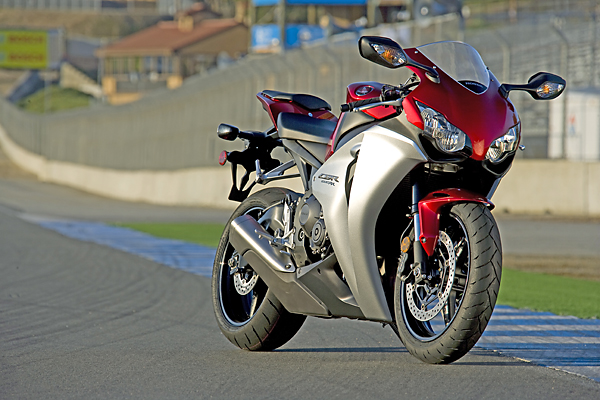
Laguna Seca throws just about everything at the rider and the machine, and as you grab gears and your gizzard over the dip on the hill approaching the Corkscrew, you’re about to test another thematic element that keeps cropping up with this motorbike. Transitions. It’s like a chorus or refrain. You know this had to be a meditative mantra for Yoshii-san and his engineers. Flicking the bike left and then, at just the right time, to the right for the famous rollercoaster, it’s amazingly easy to hit your apex. It’s nimble and responsive like a 600 with poise. If you’ve ever ridden the first generation CBR900RR then you’ll remember how important this agility is to Honda. The ensuing generations of motorcycles have obviously left that ride as relevant as a neolithic wagon wheel, but the response and precision of a MotoGP bike can be felt in every corner without the vague and nervous feeling of its long dead ancestor. And as you roll back on the throttle during this plunge down the Corkscrew, you can be thankful for the HESD. Sleeping in the pits and napping in the smoother bits, the unit is fully awake and on the job where it needs to be.
Honda’s theme of mass centralization is evident in the pitch to the right down the Corkscrew. Riding the ’07 1000RR back-to-back with the ’08 makes this crystal clear. It is an accomplishment because the ’07 isn’t exactly a porker (curb weight is around 452 lbs). The ’07 is noticeably wider with a higher center of gravity, and it doesn’t turn quite so well. That’s definitely a consequence of an updated geometry … with a tenth of a degree less rake (23.3 deg) and a whopping 3.8mm less trail (96.2mm). It’s an interesting fact that the ’08 is now running similar geometry to the ’07 CBR600RR.
It should be said at some point that the bike only truly came alive around Laguna once Terry Newby of Sport Tire Services fitted Dunlop’s latest D211 GPs. This wasn’t a tire test, so we can only compare the OEM Dunlop Sportmax tires against these soon-to-be available WMDs. The CBR1000RR is a streetbike and it comes with street tires. They work well in most conditions, they wear like they should, and they’re resistant to heat cycles. That being said, they’re not appropriate for fast laps around a racetrack. Of course, this is why Honda arranged for the D211s. I was never very comfortable riding around Laguna on the OEMs. On the track they were vague, and more than once I found my knee suddenly flat on the tarmac when only moments before it had just been barely skimming. That sudden increase in lean angle was a bit disconcerting, and I would have had to find another explanation had it not disappeared outright with the fitment of Dunlop’s latest and greatest. Honda test rider and former World Endurance Champion Doug Toland was puzzled by my observation, but I’ll stick by it. The OEMs will serve you well in all street conditions, but they’re not appropriate for the racetrack.

No lap around Laguna is complete without an eyeball peeling romp over Turn 1 at over 140mph. Doug Toland claims his speedo reads over 160mph at the bridge, but I was too lily livered to look. The large tachometer is the prime focus of the instrument cluster, and I’m ashamed to say that I never once glanced at the speedometer. But I did notice on my out lap that Honda provides a mileage estimate on the tastefully laid out cluster. There’s even a shift light before the rev limiter, but again, I was too busy having fun and looking where I wanted to go rather than exploring the clocks.
I took the shameful pacifier approaching Turn 1 and short shifted my way over the crest. I did my best to prepare for coming out of lightspeed for Turn 2. Here again the brakes did their job just fine, but at an ever increasing amount of effort. I tried adjusting my brake lever a bit in the pits, but I couldn’t shake the brake fade. It was never dangerous by any stretch, but after enough laps it was definitely noticeable. I can’t help but wonder if the aluminum pistons in the new calipers weren’t conducting too much heat back into the hydraulic system. I did get a chance to ride an HRC kitted CBR600RR, and I must say that even though it was probably just as heavy it was much easier to brake and felt like my 250 of yesteryear. This should give Honda something to do this year while they kick back and catch their breath after knocking our socks off with this seminal motorcycle.
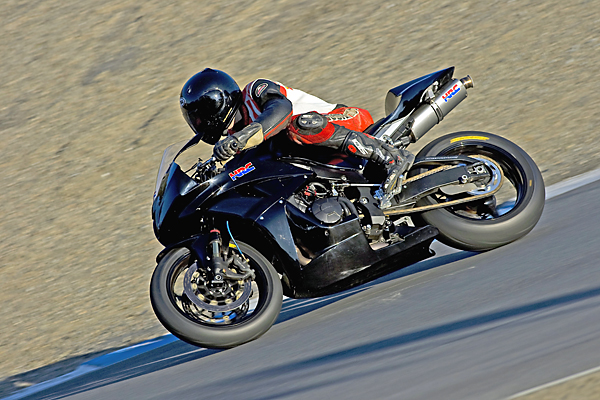
We had the chance to ride an HRC kitted 600 . . . pretty cool
And once you catch your breath, you might decide to exhale and buy a few Honda CBR Accessories. Several are already available, but I was only able to sample the new “e-cushion” or ‘Energy Cushion’ seat. Honda claims the seat to be more durable than a gel seat. They were so proud of the seat that they couldn’t wait for us to try it. They made a point of installing the accessory seat along with the new Dunlop D211s during the lunch break. Good thing too. It’s a winner. I wasn’t sure it was worth mentioning to Honda, but the stock seat was really slippery. It was hard to keep a good, solid riding position while hanging off the bike. The new seat fixed all of that, and it ceased to be a problem.
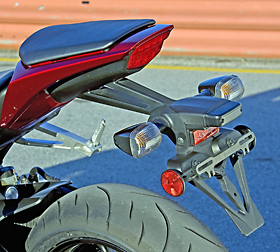
If you’re a racer or a track day rider, you’ll love how the entire license plate and turn indicator platform unbolts in one piece a la the Yamaha R6. Racers also have HRC power up kits available, and Honda made it a point to promise us that racers will definitely be able to purchase these kits from any Honda dealer, Scout’s Honour.
In short, this is a 1000cc beast, cleaned up, coifed, and barely domesticated. Honda feels a great deal of social responsibility in releasing a weapon like this. Of course, they’d also like you to live to buy the 2010 evolution, so a lot of effort has been placed on making this bike maintain impressive specifications and still allow mortals to do amazing things with it. We could gush over the horsepower or try to find new and clever ways to say, “Hey, dude, this bike is fast.” But that would be a waste of your time.
As I sit here and mull over my experience on the ’08 CBR1000RR, I’m not reminiscing over a horsepower fix or adrenaline rush. I’m just struck by how civilized this bike is. Like a giant silverback gorilla next to you in line at Starbucks that orders a vanilla latte. Even though he doesn’t have any money on him, you know the barista just won’t say no. And the gorilla even says, “please”.
From a rider’s perspective, there is precious little the 2008 Honda CBR1000RR doesn’t do with calculated success. It works so well because of the dedication and accuracy of its design and engineering. It’s not exactly rolling art, so you won’t have to worry about paying for that. And with an MSRP of $11599 you really can ride it like you stole it. So when you flick your new ’08 onto your knee and feed the roaring animal so cleverly ensconced beneath you, remember where it came from and give Nicky and Yoshii-san a salubrious, soul-nourishing wheelie. They understand.
The 2008 CBR1000RR has a U.S. MSRP of $11,599. It will be available in the four color schemes shown in the photo below. For additional details and specifications, visit Honda’s web site here.
